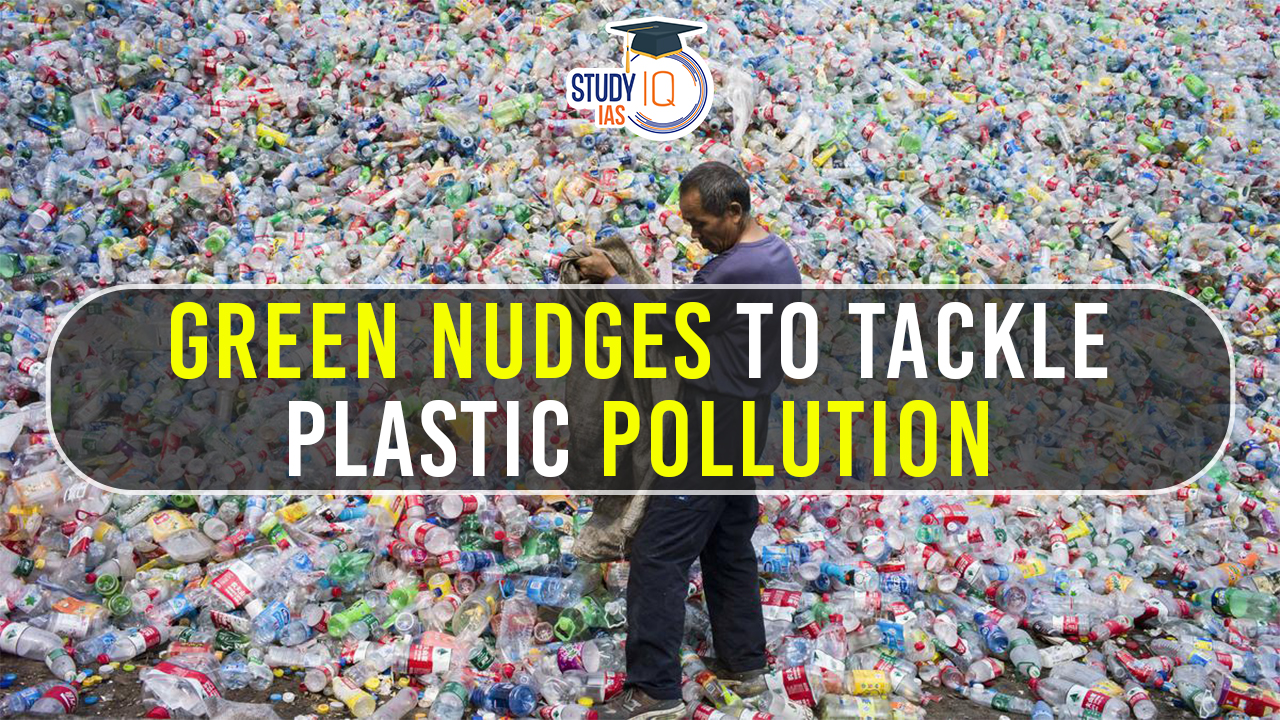Table of Contents
Context: A study conducted in collaboration with an online food delivery platform in China found that making “no disposable cutlery” the default choice for orders and rewarding customers with “green points” led to a 648% increase in the share of no-cutlery orders.
More on News:
- The study was carried out to analyse customer-level response to green nudges by promoting “no cutlery”, and setting up a reward system where points can be redeemed for planting trees in China’s deserts.
- This could also help reduce plastic pollution significantly.
Understanding Green Nudges:
- What is it?
- Green nudges are gentle, non-coercive interventions designed to encourage environmentally friendly behavior in individuals.
- These nudges are based on the principles of behavioural economics and aim to influence people’s choices without limiting their options.
- Purpose of Green Nudges:
- Reduce Single-Use Plastics: The main objective is to reduce the use of single-use plastics, specifically single-use cutlery (SUC) in food deliveries thereby reducing environmental plastic pollution.
- Promote Sustainable Behavior: The green nudges aim to nudge customers into making more sustainable choices without restricting their options.
- Comply with Regulations: Compliance with these regulations was a key part of the purpose behind implementing these nudges.
- Support National Sustainability Goals: The green nudges aligned with the Chinese national goals of phasing out single-use plastics and reduce plastic waste thereby promoting a more sustainable approach to food delivery.
- Does India have a similar initiative? Zomato reported a positive response to its “no-cutlery” initiative in India, with three out of every five orders choosing to opt out of receiving cutlery.
Growing Menace of Plastic Pollution:
What is Plastic Pollution?
- Plastic is a synthetic organic polymer made from petroleum with properties ideally suited for a wide variety of applications, including packaging, building and construction, household, electronics, agriculture etc.
- It is non-biodegradable in nature and persists in the environment, for hundreds or even thousands) of years.
- Plastic pollution is caused by the accumulation of this plastic waste in the environment.
- It can be categorized as primary plastic wastes such as cigarette butts and bottle caps, or secondary plastic wastes that are formed by the degradation of the primary ones.
- As per the UN, over 300 million tons of plastic are produced every year and India generates 46 million tonnes of plastic waste annually, of which 40% remains uncollected and 43% is used for packaging, most of which are of single-use plastic.
Sources of Plastic Pollution:
- The main sources of marine plastic are land-based, from urban and storm runoff, sewer overflows, beach visitors, inadequate waste disposal and management, industrial activities, construction and illegal dumping.
- Ocean-based plastic originates mainly from the fishing industry, nautical activities and aquaculture.
- Under the influence of solar UV radiation, wind, currents and other natural factors, plastic fragments into small particles, termed microplastics (particles smaller than 5 mm) or nanoplastics (particles smaller than 100 nm).
Types of Plastic Waste:
- Microplastics are small plastic pieces of less than five millimeters in size.
- Microplastic includes microbeads (solid plastic particles of less than one millimeter in their largest dimension) that are used in cosmetics and personal care products, industrial scrubbers which are used for aggressive blast cleaning, microfibers used in textiles and virgin resin pellets used in plastic manufacturing processes.
- Single-use plastic is a disposable material that can be used only once before it is either thrown away or recycled, like plastic bags, water bottles, soda bottles, straws, plastic plates, cups, most food packaging and coffee stirrers are sources of single use plastic.
- India has announced its commitment to eliminate single-use plastic by 2022 at Confederation of Indian Industry’s Sustainability Summit in New Delhi.
Current State of Plastic pollution:
- As per the 2023 Plastic Overshoot Day Report released by Swiss-based research consultancy Earth Action (EA):
- On July 28, 2023, the Earth saw its first Plastic Overshoot Day and India saw its Plastic Overshoot Day on 6 th January 2023.
- Overshoot Day is the day when the generation of plastic waste exceeds the capacity of waste management, leading to environmental pollution.
- It is based on the country’s Mismanaged Waste Index (MWI), i.e., the mismanaged and total waste ratio.
- India is among the 12 countries responsible for 52% of the world’s mismanaged plastic waste.
- On July 28, 2023, the Earth saw its first Plastic Overshoot Day and India saw its Plastic Overshoot Day on 6 th January 2023.
- According to the Central Pollution Control Board (CPCB), India generates close to 26,000 tonnes of plastic a day and over 10,000 tonnes a day of plastic waste remains uncollected.
- According to a Federation of Indian Chambers of Commerce and Industry (FICCI) study the plastic processing industry is estimated to grow to 22 million tonnes (MT) a year by 2020 from 13.4 MT in 2015 and nearly half of this is single-use plastic.
- India’s per capita plastic consumption of less than 11 kg, is nearly a tenth of the United States of America (109 kg).
Plastic Life-Cycle Report by Centre for Science and Environment (CSE):
As per the report,
The landscape of plastic waste pollution and management
Global scenario:
- The global production of plastic increased by 79 per cent within a decade and a half (between 2000 and 2015).
- Roughly 80 per cent of all the plastics ever produced continues to remain in the environment.
- Total mass of plastics on our planet is now twice the mass of all living mammals.
- If the plastic industry were a country, it would be the fifth largest greenhouse gas emitter on Earth.
Indian scenario:
- Plastic consumption: A whopping 18.45 million metric tonne (MMT) of plastic was consumed in India in the year 2018-19; 59 per cent of this went into packaging.
- Multi-layered plastics: Which are non-recyclable at a commercial scale, made up 35 per cent of all plastic waste, and 40 per cent of all branded plastic waste.
- Plastic waste recycling:

Threats/Impact of Plastic Pollution:
- Economic Losses: Plastic waste along shoreline has a negative impact on tourism revenue (creates an aesthetic issue). For example, the Andaman and Nicobar Islands are facing the aesthetic issue because of the international dumping of plastic waste at the island.
- Impact on Animals: Plastic wastes have profoundly affected animals in aquatic, marine, and terrestrial ecosystems.
- Plastic ingestion upsets or fills up the digestive systems of the animals thus contributing to their death due to intestinal blockage or starvation.
- Impact on Human Health: The chemicals leached from the plastics contain compounds, like polybrominated diphenyl ether (anti-androgen), bisphenol A (mimics the natural female hormone estrogen) and phthalates (also known as anti-androgens), impact human health leading to various hormonal and genetic disorders.
- Land Pollution: Plastics leach hazardous chemicals on land, resulting in the destruction and decline in quality of the earth’s land surfaces in term of use, landscape and ability to support life forms.
- Air Pollution: Plastic burning releases poisonous chemicals into the atmosphere impacting general well-being and causing respiratory disorders in living beings.
- Groundwater Pollution: Whenever plastics are dumped in landfills, the hazardous chemicals present in them seep underground when it rains. The leaching chemicals and toxic elements infiltrate into the aquifers and water table, indirectly affecting groundwater quality.
- Water Pollution: In 2014, United Nation report estimated the annual impact of plastic pollution on oceans at US$ 13 billion.
- Interference with the Food Chain: When the smaller animals (planktons, mollusks, worms, fishes, insects, and amphibians) are intoxicated by ingesting plastic, they are passed on to the larger animals disrupting the interrelated connections within the food chain.
Shortcomings in handling plastic pollution in India:
- Weak waste management systems: Lagging to meet the growing needs.
- Insufficient data and reporting: as the products are scattered into diverse sectors.
- Use of Single-Use Plastics which has short lifespan and widespread use.
- Poor implementation of policies: Like Plastic Waste Management Amendment Rules, 2021.
- Consumer’s behaviour: which are currently aligned with the usage of plastic disposables.
- Lack of a suitable alternative: which are either too costly or difficult to produce in mass.
Initiatives:
Global Initiatives:
- The 1972 Convention on the Prevention of Marine Pollution by Dumping Wastes and Other Matter (or the London Convention).
- The 1996 Protocol to the London Convention (the London Protocol).
- The 1978 Protocol to the International Convention for the Prevention of Pollution from Ships (MARPOL).
- The United Nations Environment Program (UNEP) considers plastic marine debris and its ability to transport harmful substances as one of the main emerging issues affecting the environment.
- GloLitter Partnerships (GLP): It is a project launched by the International Maritime Organization (IMO) and the Food and Agriculture Organization of the United Nations (FAO) and initial funding from the Government of Norway.
- Clean Seas Campaign:
- The United Nations Environment Programme launched the Clean Seas Campaign in 2017 to reduce the use of unnecessary, avoidable and problematic plastics including single-use plastics and phase out intentionally added microplastics.
- The Campaign contributes to the goals of the Global Partnership on Marine Litter and the New Plastics Economy Global Commitment.
- UNEA’s Resolution to “End Plastic Pollution”: 175 countries have endorsed the UN Environment Assembly (UNEA-5) resolution in Nairobi to End Plastic Pollution and forge an international legally binding agreement by 2024.
Indian Initiatives:
- The Plastic Waste Management Rules, 2016 clearly stipulate that urban local bodies (ULBs) should ban less than 50 micron thick plastic bags and not allow usage of recycled plastics for packing food, beverage or any other eatables.
- The Rules also require that local bodies should provide separate collection, storage and processing of plastic waste in their areas.
- Plastic Waste Management (Amendment) Rules, 2021:
- Prohibits the manufacture, import, stocking, distribution, sale and use of single-use plastics.
- The thickness of plastic carry bags increased from 50 to 75 microns from 30th September 2021 and to 120 microns with effect from 31st December 2022.
- Extended Producer Responsibility guidelines made applicable to plastic producers.
- India is a signatory to MARPOL (International Convention on Prevention of Marine Pollution).
- Plastic Waste Management (Amendment) Rules, 2022: To strengthen the circular economy of plastic packaging waste and development of recycling infrastructure for plastic packaging waste.
- India Plastic Pact: It is the first of its kind in Asia. The Plastics Pact is an ambitious and collaborative initiative to bring stakeholders together to reduce, reuse and recycle plastics within the material’s value chain.
Way Forward:
- Incentivize Recycling: Offer incentives for plastic recycling and recovery.
- Raise Awareness: Educate the public about plastic pollution’s impact.
- Enforce Regulations: Strengthen enforcement of plastic pollution rules.
- Empower Pollution Control: Enhance Pollution Control Board’s capabilities.
- Circular Economy: Implement circular economy practices for plastics.
- Identify Hotspots: Pinpoint plastic leakage areas for targeted action.
- Promote Alternatives: Replace plastics with recyclable or biodegradable materials.
- Oxo-Biodegradable Plastics: Encourage faster biodegradation plastics.
- Plastic-Eating Bacteria: Harness plastic-digesting bacteria for waste reduction.
- Recycling Innovation: Develop technologies like plastic-based tiles.
- Plastic-Free Workplaces: Ban single-use plastics in workplaces.
- Collaboration: Engage government, industry, NGOs, and volunteers.


 SIPRI Report on Global Arms Spending and...
SIPRI Report on Global Arms Spending and...
 National Mission for Clean Ganga (NMCG)
National Mission for Clean Ganga (NMCG)
 Phenome India Project: Mapping India's H...
Phenome India Project: Mapping India's H...





















